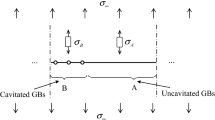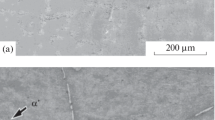Abstract
We present an estimate of the partial pressure of methane in microvoids under the conditions of hydrogen corrosion in 2.25Cr-1Mo steel. On the basis of the thermodynamic analysis of a two-phase (metalmicrovoid) system containing hydrogen and Me3C, Me7C3, and Me23C6-type carbides as thermodynamic components, we suggest a new scheme for the evaluation of the partial pressure of methane in the microvoids of the metal. We give an example of the evaluation of the pressure of methane in internal cavities in steel at a temperature of 500°C for a simplified case where the formation of methane is controlled by the amount of carbon formed as a result of the decomposition of carbides. Unlike the previous computational schemes, in the proposed scheme, pressure depends on the radius of the microvoid. In the general case, this approach also takes into account the distance between the analyzed layer and the metal surface, the width of the decarbonized zone, the rates of carbon and hydrogen diffusion in the metal, and many other parameters.
Similar content being viewed by others
References
M. F. Ashby, “Mechanisms of deformation and fracture,”Adv. Appl. Mech.,23, 117–177 (1983).
H. J. Frost and M. F. Ashby,Deformation-Mechanism Maps, Pergamon Press (1982).
I. Chadek,Creep of Metallic Materials [Russian translation], Mir, Moscow (1987).
J. Friedel,Dislocations [Russian translation], Mir, Moscow (1967).
D. Hull and D. E. Rimmer, “The growth of grain-boundary voids under stress,”Phil. Mag.,4, 673–687 (1959).
J. Raj and M. F. Ashby, “Intergranular fracture at elevated temperature,”Acta Met.,23, 653 (1975).
A. Needleman and J. R. Rice, “Plastic creep flow effects in the diffusive cavitation of grain boundaries,”Acta Met.,28, 1315–1332 (1980).
I. D. Skrypnyk, “High-temperature voids growth due to grain-boundary diffusion,” in: O. M. Romaniv and S. Ya. Yarema (editors),Fracture Mechanics, Strength and Integrity of Materials, Karpenko Physicomechanical Institute, Ukrainian Academy of Sciences, L'viv (1996), pp. 157–168.
V. I. Pokhmurs'kyi and V. V. Fedorov, “Some distinctive features of the influence of hydrogen on the magnetic and structural transformations in transient metals and alloys based on these metals,”Fiz-Khim. Mekh. Mater.,17, No. 1, 3–11 (1981).
G. V. Karpenko, A. K. Litvin, V. I. Tkachev, and A. I. Soshko, “On the mechanism of hydrogen embrittlement,”Fiz-Khim. Mekh. Mater.,9, No. 4, 6–12 (1973).
V. V. Popovich, “Adsorption-induced facilitation of the deformation and fracture of iron in the presence of hydrogen,”Fiz-Khim. Mekh. Mater.,17, No. 6, 36–39 (1981).
C. A. Zapfe and G. Sims, “Hydrogen embrittlement in engineering materials, internal stress and defects in steel,”Trans. ASME,145, 225–259 (1941).
C. A. Zapfe, “Hydrogen theory for brittle shipplate,”Met. Progr.,39, No. 6, 802–808 (1941).
B. A. Kolachev,Hydrogen Embrittlement of Metals [in Russian], Metallurgiya, Moscow (1985).
L. A. Kurtasova and V. M. Polyanskii, “Nature of the near-boundary defects and their role in the corrosion cracking of aluminum alloys,”Fiz-Khim. Mekh. Mater.,16, No. 4, 7–12 (1980).
I. D. Skrypnyk, “Analytic evaluation of hydrogen-assisted void growth at high temperatures,”Fiz-Khim. Mekh. Mater.,33, No. 4, 75–86 (1997).
Yu. I. Archakov,Hydrogen Resistance of Steel [in Russian], Metallurgiya, Moscow (1979).
P. G. Shewmon, “Hydrogen attack of carbon steel,”Metal. Trans.,7A, February, 279–286 (1976).
M. W. D. van der Burg, E. van der Giessen, and R. C. Brouwer, “Investigation of hydrogen attack in 2.25Cr-1Mo steels with a hightriaxiality void growth model,”Acta Mater.,44, No. 2, 505–518 (1996).
M. W. D. van der Burg,Hydrogen Attack, Micromechanical Modelling on Three Length Scales, Ph. D. Thesis, TU Delft, the Netherlands (1997).
R. Lungberg, M. Waldenstorm, and B. Uhrenius,CALPHAD,1, 159–199 (1977).
T. A. Parthasarathy and P. G. Shewmon, “Effect of tempering on the carbon activity and hydrogen attack of 2.25Cr-1Mo steel,”Metal. Trans.,15A, November, 2021–2027 (1984).
O. Kubaschewski and C. B. Alcock,Metallurgical Thermochemistry, Pergamon Press (1979).
G. R. Odette and S. S. Vagarali, “An equation of state for methane for modelling hydrogen attack in ferritic steels,”Metal. Trans.,13A, February, 299–303 (1982).
L. S. Moroz and B. B. Chechulin,Hydrogen Embrittlement of Metals [in Russian], Metallurgiya, Moscow (1967).
P. H. Emmet and R. W. Harkness, “Adsorption of hydrogen by iron synthetic ammonia catalysts,”J. Amer. Chem. Soc.,57, 1631 (1935).
G. Schultze,Physics of Metals [Russian translation], Mir, Moscow (1971).
Additional information
Karpenko Physicomechanical Institute, Ukrainian Academy of Sciences, L'viv. Published in Fizyko-Khimichna Mekhanika Materialiv. Vol. 34, No. 4, pp. 57–64, July–August, 1998
Rights and permissions
About this article
Cite this article
Nykyforchyn, H.M., Skrypnyk, I.D. & Didukh, P.M. Analytic evaluation of the pressure of methane in microvoids of 2.25Cr-1Mo steel subjected to hydrogen attack. Mater Sci 34, 512–520 (1998). https://doi.org/10.1007/BF02360703
Received:
Issue Date:
DOI: https://doi.org/10.1007/BF02360703




